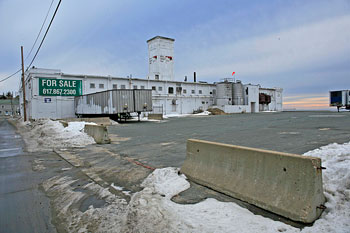Harbor Porpoise Take Reduction Plan Amended

The closed Birdseye fish plant in Gloucester. The town has been hit hard by groundfish quota cuts for years, the heaviest coming this year. Problems with harbor seals have compounded the difficulty keeping the shore side businesses open. © Photo by Sam Murfitt
GLOUCESTER, Mass October 9. 2013
The following was released by the Northeast Seafood Coalition:
Last year, gillnet fishermen were facing a consequence closure in a large portion of the Gulf of Maine for October and November due to analysis conducted by the National Marine Fisheries Service (NMFS) that indicated harbor porpoise bycatch exceeded the scientifically allowable limit based on the estimated population size. NSC, along with other members of the fishing industry, questioned the calculations underlining the trigger.
NSC also worked closely with affected gillnetters, sector managers and the Northeast Sector Service Network to conduct a thorough review of Northeast Fishery Science Center data and to submit an industry proposal to NOAA Fisheries that not only better reflected the current Northeast groundfish fishery, but also prompted a data review of harbor porpoise takes and fishing behavior.
NSC identified the “Other Special Measures Provision” in the Plan that allowed regulatory flexibility to modify the consequence closure in Fishing Year 2012 from the fall months to February and March 2013. The modification was an industry trade-off to conserve harbor porpoise with less financial impact to the fishery.
In NSC’s public comments for the proposed rule to amend the Plan, NSC executive director Jackie Odell wrote, “Data now reveals the trigger is misaligned with the true realities of the current fishery and is essentially disconnected. Although these facts would have been useful prior to enactment of the existing closure, perpetuating the Coastal Gulf of Maine Consequence Closure Area and/or triggering additional consequence closures under these facts and circumstances would be wrong.”
Now, the Gloucester-based industry group is gearing up for the next potential threat to the already-reeling Northeast groundfish industry: the Habitat Omnibus Amendment.
It’s all about habitat,” NSC executive director Jackie Odell said when asked what’s next on the coalition’s agenda. And with good reason. The crafting of the Habitat Omnibus Amendment ultimately will determine the specific areas of the ocean that will be open to fishermen in the Northeast multispecies fishery. The modifications are expected to take effect in the winter of 2015. It is an extraordinarily complex process, now moving into its sixth year. It is heavily driven by science and varying perspective – and thus often rife with the contention and disagreement that have emerged as the hallmarks of the effort to sustain and govern the American commercial fishing industry.
The coalition has submitted its public comments to the council that, at least in part, underscore those differences. They include: “Any habitat area considered for protecting spawning or juvenile fish should be developed for a future management action. First, the (Closed Area Technical Team) work has appeared very late in the amendment process. There has been inadequate time for stakeholders to participate and react to these alternatives that will impose great hardship for many fishing businesses. Second, there is serious concern with the scientific information and data being used to identify and justify such areas. Third, in many cases, the alternatives put forth by CATT conflict with the efforts of stakeholders over the years to work closely together to craft thoughtful alternatives in the amendment.”
